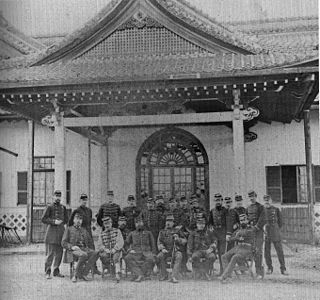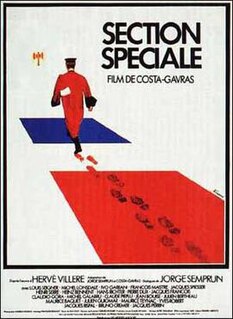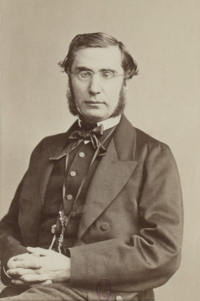
The Prytanée national militaire is a French military school managed by the French military, offering regular secondary education as well as special preparatory classes, equivalent in level to the first years of university, for students who wish to enter French military academies. The school is located in western France in the city of La Flèche.

The history of relations between France and Japan goes back to the early 17th century, when a Japanese samurai and ambassador on his way to Rome landed for a few days in Saint-Tropez and created a sensation. France and Japan have enjoyed a very robust and progressive relationship spanning centuries through various contacts in each other's countries by senior representatives, strategic efforts, and cultural exchanges.

Louis-Émile Bertin was a French naval engineer, one of the foremost of his time, and a proponent of the "Jeune École" philosophy of using light, but powerfully armed warships instead of large battleships.

The Journal des débats was a French newspaper, published between 1789 and 1944 that changed title several times. Created shortly after the first meeting of the Estates-General of 1789, it was, after the outbreak of the French Revolution, the exact record of the debates of the National Assembly, under the title Journal des Débats et des Décrets.

Lycée Janson de Sailly is a lycée located in the 16th arrondissement of Paris, France. The lycéens of Janson are called les jansoniens and they usually refer to their high school as Janson, or JdS. It is the biggest academic institution in the region: 3,200 boys and girls from 11 to 20 attend classes ranging from junior high school to Classes Préparatoires.

The French Military Mission to Japan of 1867-68 was one of the first foreign military training missions to Japan. The mission was formed by Napoléon III, following a request of the Japanese Shogunate in the person of its emissary to Europe, Shibata Takenaka (1823–1877).

Jules Brunet was a French Army officer who played a famous role in the Japanese Boshin War. He was sent to Japan with the French military mission of 1867 and after the defeat of the shōgun had an important role in the Republic of Ezo. He later became a General and Chief of Staff of the French Minister of War in 1898.

The 1872–1880 French military mission to Japan was the second French military mission to that country. It followed the first French military mission to Japan (1867–68), which had ended with the Boshin War and the establishment of the rule of Emperor Meiji.

Section spéciale is a 1975 French film directed by Costa-Gavras and based on the novel L'affaire de la Section Spéciale by Hervé Villeré. It stars Louis Seigner, Roland Bertin, Michael Lonsdale, Ivo Garrani, François Maistre, Jacques Spiesser, Henri Serre, Heinz Bennent and Claude Piéplu. It is named after the Special Sections of Vichy France.

The development of France-Japan relations in the 19th century coincided with Japan's opening to the Western world, following two centuries of seclusion under the "Sakoku" system and France's expansionist policy in Asia. The two countries became very important partners from the second half of the 19th century in the military, economic, legal and artistic fields. The Bakufu modernized its army through the assistance of French military missions, and Japan later relied on France for several aspects of its modernization, particularly the development of a shipbuilding industry during the early years of the Imperial Japanese Navy, and the development of a Legal code. France also derived part of its modern artistic inspiration from Japanese art, essentially through Japonism and its influence on Impressionism, and almost completely relied on Japan for its prosperous silk industry
Christian Philippe Polak is a French businessman and author who has published several books on 19th-century Franco-Japanese relations; one Le Monde book review called him "the best specialist on this question".
Events from the year 1868 in France.

French–Vietnamese relations started as early as the 17th century with the mission of the Jesuit father Alexandre de Rhodes. Various traders would visit Vietnam during the 18th century, until the major involvement of French forces under Pigneau de Béhaine from 1787 to 1789 helped establish the Nguyễn Dynasty. France was heavily involved in Vietnam in the 19th century under the pretext of protecting the work of Catholic missionaries in the country.

The Military governor of Paris is a post within the French Army. He commands the garrison of Paris and represents all the military based in Paris at high state occasions. He is also responsible for organizing major national ceremonies such as the Bastille Day military parade down the Champs-Élysées.

Olivier Émile Ollivier was a French statesman. Starting as an avid republican opposed to Emperor Napoleon III, he pushed the Emperor toward liberal reforms and in turn came increasingly into Napoleon's grip. He entered the cabinet and was the prime minister when Napoleon fell.
Louis-Frédéric Nussbaum, also known as Louis Frédéric or Louis-Frédéric (1923–1996), was a French scholar, art historian, writer and editor. He was a specialist in the cultures of Asia, especially India and Japan.
Charles Derennes was a French novelist, essayist and poet, the winner of the Prix Femina in 1924.

François Gérard Marie Lecointre is a French army general serving as Chief of the Defence Staff since 20 July 2017. As a captain, with Lieutenant Bruno Heluin, as the company commanding officer, one of the two heroes of the Battle of Vrbanja Bridge in 1995, the last Fixed Bayonet Charge combat of the French Armed Forces.

Louis Gonse was an art historian, Editor-in-Chief of the Gazette des Beaux-Arts and Vice-President of the Commission for Historic Monuments. He was also one of the first European experts in Japanese art.














